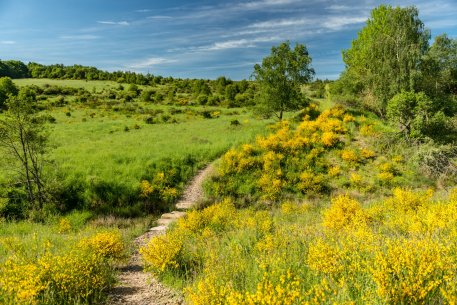Mown meadows and land grazed by sheep or cattle is designated as grassland
In addition to the forests, these biotopes are also widespread in the Eifel National Park. They are especially prevalent on the Dreiborn Plateau and in the broad river valleys in the National Park districts of Hetzingen, Dederborn and Wahlerscheid. You can differentiate between various types of grassland, depending on the level of nutrients and water supply to the soil, and on the type of use.
The National Park is home to low-nutrient, low-growth matgrass and meum athamanticum meadows; richer gold and oatgrass meadows with taller grasses; and wet or wetland meadows with their bulrushes and brightly coloured, tall flowering shrubs. Grassland with fewer species can be found on the Dreiborn Plateau. This area was formerly used as the Vogelsang military training area. Damage to the ground caused by previous military manoeuvres has had to be remedied through the repeated sowing of grasses. This has meant that, in some areas, it has not been possible to establish species-rich pasture vegetation.
The wet grasslands by the riverbanks, particularly in the National Park districts of Dedenborn and Wahlerscheid, were often not used commercially in the past and became fallow land. Tall shrubs took over an increasing amount of space and squeezed out the lower-growing grasses and herbs.
A variety of rare animal, fungi and plant species can be found in the meadows and pasturelands. From a conservation perspective, the brightly flowering grassland in the spring and early summer is a wonderful feature of the National Park. Within the management zone, this is to be preserved through regular mowing or grazing.

